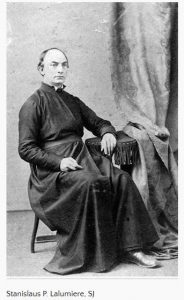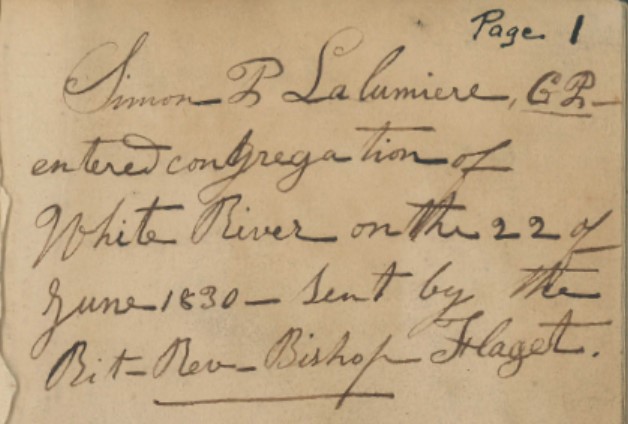On June 22, 1830, Fr. Simon Petit Lalumiere, a native of Vincennes, and a priest of the Diocese of Bardstown, who had been sent by Bishop Benedict Joseph Flaget to Indiana, arrived at a place called “Black Oak Ridge” in Daviess County. Lalumiere wrote in his Sacramental Register, which he carried with him:
Simon P. Lalumiere CP entered congregation of White River on the 22 of June 1830-Sent by the Rt Rev Bishop Flaget 1
This was the beginning of the parish of St. Peter on “Black Oak Ridge” with a resident pastor. The parish was actually founded about 1818. Father Lalumiere arrived as the first resident pastor, in the summer of 1830.
Fr. Robert Gorman, in his unpublished History of the Diocese, wrote:
On his visitation of 1829 Bishop Flaget certainly became aware of the agitation for the establishment of a parish at Black Oak Ridge. For some years the rather numerous Catholics in this locality had been most anxious for the appointment of a resident pastor and the erection of a new church. For the latter purpose William Dant and his mother had donated a tract of 80 acres with some improvements, about six miles from Washington. Flaget could not send any of his native Kentuckians but in 1830 appointed a native son of Indiana, Father Simon Lalumiere, as pastor. Father Lalumiere was the son of Anthony Petit, born in 1804, the year of Father Rivet’s death. According to Cauthorn, his parents were not of the old Vincennes stock but were immigrants from France, and his father adopted the soubriquet Lalumiere which became the family name. He was baptized by Donatien Oivier, November 11, 1804 about two months after his birth. Nothing is known concerning his early years but he must have been influenced by the good priests who served Vincennes possibly by Jeanjean and certainly by Champomier He studied under Bishop David in St. Thomas Seminary, Bardstown and was ordained in 1830. He was sent immediately to Black Oak Ridge. An indefatigable and self-effacing missionary, he performed invaluable services for the. Church in Indiana, cooperated faithfully with his co-laborers and set an excellent standard for the clergy. Due to his birth and training he was especially equipped to be the apostle to the native American Catholics.
There were well over a hundred Catholic families located between the forks of the White River at this time. The new pastor immediately undertook the work of erecting the church at Black Oak Ridge but this was only his headquarters. Mt. Pleasant was a station which he must have attended with some regularity and he soon found the incipient organization of a parish in the group located at Boggs Creek. Probably not long after his arrival in Daviess County he said mass in the home of Nathaniel Spalding which became the center of the new mission. Flaget also gave him the more distant charge of Shelby County which he visited in the spring~ and fall. His first trip to these emigrants from Scott County was made either late in 1830 or early in 1831 when he found only four or five Catholic families. But these were anxious for a church and a Protestant gentleman offered a lot of five acres suitably located. On these journeys he followed the East Fork of the White River through Rockford and Columbus. Ultimately he extended them to Richmond and even to Fort Wayne. An account of such a tour, made undoubtedly by Lalumiere during the Easter season of 1833 was printed in the Catholic Telegraph of Cincinnati, May 18, 1833. The missionary found four or five Catholic families in Columbus, some of whom had not heard mass for years. He gave a short exposition of the doctrines of the Church to a large assembly in the court house and found, according to the correspondents report, that many seemed to be surprised at knowing that Catholics believed in Jesus Christ. In Shelby County he found ten Catholic families, some of whom had just arrived during 1833. About twenty five persons approached the sacraments and , although services were held in a private home the Litany of Loretto was sung before mass and hymns during the services. 2
Father Lalumiere himself wrote about this area in 1833:
In Daviess county, where, at St. Peter’s Church, we have the Female School, there is yet much vacant land, and lands already improved, can be had on the most favorable terms. The advantage of the situation between the Forks of White River affords every needful facility for transporting produce to market. St. Peters and the School are situatiod within half a mile of the State road leading from Vincennes to Louisville, and equi-distant from either fork of White River; and equidistant from the church and the West Fork, stands Washington, the county seat, a little town, flourishing, both now and in prospect. A church will probably here long be erected in it. The distance between the two forks, as the road runs, is 18 miles. The climate is healthful, and the priest very seldom has to attend a sick call. The resident clergyman at St. Peters, is a native of the State, and familiar with both the French and English languages.
 Over the years, there existed a photograph, identified as “S. Lalumiere” It was always thought that it was a photo of Fr. Simon. However, it turns out that Fr. Simon had a nephew, born in 1822, named “Stanislaus” who also became a priest and was a member of the Society of Jesus. He became president of Marquette University and lived, for a time, in St. Louis. Later in life he came to Cincinnati where he died at Xavier University.
Over the years, there existed a photograph, identified as “S. Lalumiere” It was always thought that it was a photo of Fr. Simon. However, it turns out that Fr. Simon had a nephew, born in 1822, named “Stanislaus” who also became a priest and was a member of the Society of Jesus. He became president of Marquette University and lived, for a time, in St. Louis. Later in life he came to Cincinnati where he died at Xavier University.
About five years ago, we discovered an article in the Notre Dame pulbication, “The Scholastic” dated October 8, 1887, which stated:
Up until the time of the discovery of this article, the only photo of Fr. Simon was this grainy photo and it became the norm.—Among the recent additions to the Historical Collections of the University is a fine oil painting of Rev. Simon Petit Lalumiere, presented by Rev. Mother Euphrasia, General Superioress of the Sisters of Providence. When the sainted Bishop Brute, arrived at Vincennes, in 1834, to take possession of his new diocese, he found in the whole State of Indiana only one priest, the Rev. S. Lalumiere, who resided at Vincennes. He had been ordained by the venerable Bishop Flaget, of Kentucky, and was the first native of Indiana raised to the priesthood, and the first ordained for Vincennes, by the venerable Father of the western Church. The portrait was formerly owned by Rev. Father Chasse, one of the early missionaries of Indiana. Rev. Father Lalumiere, S. J., the veteran rector of St. Gall’s Church and President of Marquette College, Milwaukee, is a nephew of thelate Rev. S. P . Lalumiere, and manifests in himself those admirable qualities of mind and heart which characterized his distinguished relative. 3
We contacted the Notre Dame Archives and were told that they did not know if the painting still existed, and if so, where it may be. The paintings that hung in the hall were long ago put into storage. So, we left it at that, at least for awhile. We once again contacted them and this time the archivist who replied to our inquiry at the University did more research and the painting was found, albeit a little beat up and no longer in a frame.
We were able to get a scan of the painting and after all these years of looking at the old grainy photo of Fr. Simon, this painting, even with its flaws is a breath of fresh air. It is a bit like finding a photo of a relative and when you look at his face and his eyes, one can get the spirit of a true missionary. 4

Oil painting portrait of Rev. Simon Petit Lalumiere, circa 1850s. Property of the University of Notre Dame
Fr. Lalumiere was described as “The First Priest of Bishop Brute”. There is much to give thanks for…
- Archives, Archdiocese of Indianapolis[↩]
- Unpublished History of the Catholic Church in Indiana by Fr. Robert Gorman – Courtesy of the Archives, Archdiocese of Indianapolis[↩]
- The Scholastic – Vol-21, No. 5, October 8, 1887, p.77[↩]
- This reproducton is the property of the University of Notre Dame and may not be duplicated[↩]

